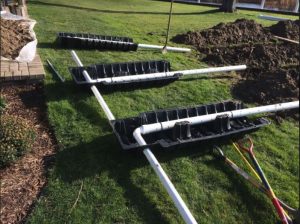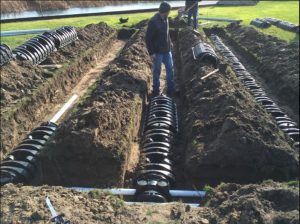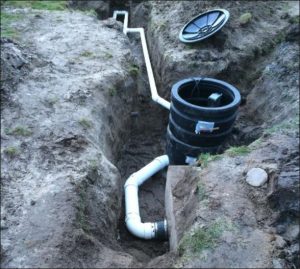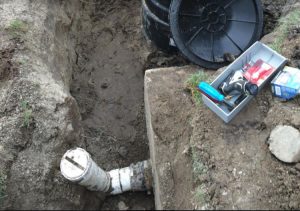My family has had a place on Harsens Island since 1957 off the Middle Channel. I’ve been going there for over 56-years and I love it there. But it needed the septic system fixed.
I had done some repairs to the old field by adding a drain tile here and there but the problem was age and the depth of the field being below grade. As we added soil to improve the grade around the cottage, we were pushing the existing septic field farther and farther below grade.
Now the field is over 20” below grade which puts it into the water table so when there are 2-day rains the field is flooded with water.
I will install a 200-gallon ‘lift tank’ next to the existing concrete septic tank. I’ll let the septic tank drain into the lift tank and I can pump the effluent into a new, higher leach field. As I researched “leach fields” I found The Infiltrator System plastic domes (about 4’ long that interlock) that are buried as shallow as 15” deep. It uses no fabric or stones and will handle more effluent for a longer period of time than the standard drain tile in a stone bed.
The funny thing about this project was I thought I needed to do it without a permit because my property was too close to the water on two sides and I’d have to condemn the property or worse.
So there I am, digging in my front yard checking for the soundness of the old septic tank. I had one hole over the access hatch and another one next to the tank checking for leaks. I had two big piles of dirt. Then, as a little boat putters by, the man calls out “Trouble with the septic field?” No, No, I yell back, I’m all good. “I’ll be right there!” he hollers as he pulls his boat to the seawall.
I ignore the boater and go to the garage for a lever and a chain to lift the tank lid. The tank lid can weigh 80lbs. I needed to pry up the lid to check the level of the effluent in the tank. If the level is low I know there is a crack in the tank and I’ll need a new one.
As I return from the garage this guy is talking to my wife and the neighbor lady. This stranger is the county health inspector. He will see my torn up yard and I’m busted. I was afraid if the county was involved I’d need a new tank and an engineered field and over $10,000 to cover the costs. I was just checking what I might need to do and the inspector shows up here.
Turns out, he says this is only a repair on my system. He likes the lift tank and the plastic field. And if done properly will only cost a $200 permit.
I researched leach field systems and looked at different styles of the plastic leach field and decide on the Infiltrator Brand because it is already in use in my area. They come in different sizes that vary the height and width to accommodate different capacities. The 8” high by 24” wide suits my site the best because I’m on a high water table area and the shallower I go the better. They are 48” long and have a capacity of 20-gallons per section which will be more than double the volume my pump will put out each cycle. I can control the volume from the pump so each ‘douse’ is not overwhelming to the field.
 The inspector was great and helped me. He agreed with me to use 3 trench legs about 30 feet long and a plumbing header to evenly disburse the effluent to the legs.
The inspector was great and helped me. He agreed with me to use 3 trench legs about 30 feet long and a plumbing header to evenly disburse the effluent to the legs.
I computed 3” pvc drain pipe tile, which has large weep holes on the sides, could hold about 1/3 of a gallon per foot. If I zip tie the drain tile to the inside top of the dome the fluid will disperse from above down to the earth. Now when the pump douses the field it will flood water down the pipe and cover the length of the trench more evenly.
The trenches were dug while I prepped the Infiltrator end-caps and in a couple of hours.
Mike’s crew from M. A. Lavis Construction dug 3-30 foot trenches, 2 feet wide and 15” deep. We used a rotating laser and a beeper on a story-pole to keep the trenches within ½” of level over the area.
As the field was snapped together, we used 200# zip ties to secure the 3” pvc to the top of the domes.

 A week later the lift tank with a riser was installed and the plumbing from the lift tank to the field was completed. I tested the system with one cycle by pumping water about ½” deep to the farthest corner of the field. I installed a cleanout there for possible air supply to the field, to see how well a douse of water filled the trench, and to monitor the system in the future.
A week later the lift tank with a riser was installed and the plumbing from the lift tank to the field was completed. I tested the system with one cycle by pumping water about ½” deep to the farthest corner of the field. I installed a cleanout there for possible air supply to the field, to see how well a douse of water filled the trench, and to monitor the system in the future.
 I then piped from the concrete septic tank to the lift tank. Since I passed the final inspection, I have one less worry in my life.
I then piped from the concrete septic tank to the lift tank. Since I passed the final inspection, I have one less worry in my life.
Total costs, $200 for a permit, $800 for leach field, $500 for a lift tank, $500 for a pump and PVC and $1,200 in labor is $3,200 for a system that should last me over 25-years.
Here is a septic system tip to check the status of an older field – add a tee with a clean out to the surface so you can check the level of effluent in the field.